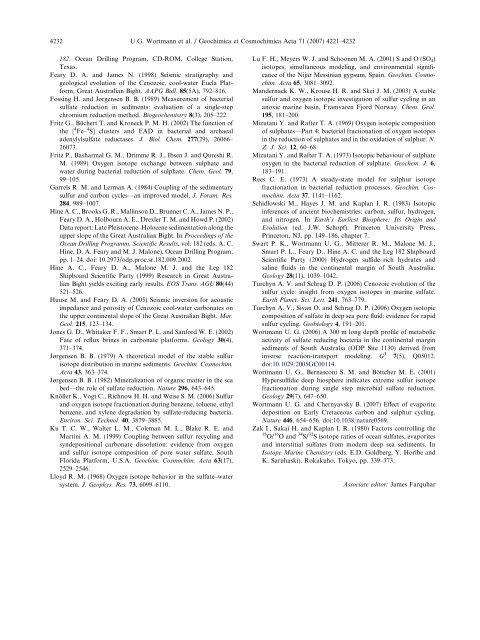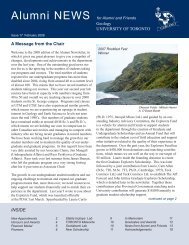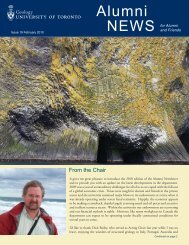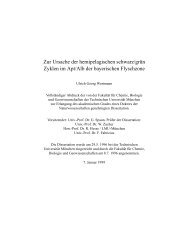Oxygen isotope biogeochemistry of pore water sulfate in the deep ...
Oxygen isotope biogeochemistry of pore water sulfate in the deep ...
Oxygen isotope biogeochemistry of pore water sulfate in the deep ...
- No tags were found...
Create successful ePaper yourself
Turn your PDF publications into a flip-book with our unique Google optimized e-Paper software.
4232 U.G. Wortmann et al. / Geochimica et Cosmochimica Acta 71 (2007) 4221–4232182. Ocean Drill<strong>in</strong>g Program, CD-ROM, College Station,Texas.Feary D. A. and James N. (1998) Seismic stratigraphy andgeological evolution <strong>of</strong> <strong>the</strong> Cenozoic, cool-<strong>water</strong> Eucla Platform,Great Australian Bight. AAPG Bull. 85(5A), 792–816.Foss<strong>in</strong>g H. and Jørgensen B. B. (1989) Measurement <strong>of</strong> bacterial<strong>sulfate</strong> reduction <strong>in</strong> sediments: evaluation <strong>of</strong> a s<strong>in</strong>gle-stepchromium reduction method. Biogeochemistry 8(3), 205–222.Fritz G., Büchert T. and Kroneck P. M. H. (2002) The function <strong>of</strong><strong>the</strong> [ 4 Fe– 4 S] clusters and FAD <strong>in</strong> bacterial and archaealadenylyl<strong>sulfate</strong> reductases. J. Biol. Chem. 277(29), 26066–26073.Fritz P., Basharmal G. M., Drimme R. J., Ibsen J. and Qureshi R.M. (1989) <strong>Oxygen</strong> <strong>isotope</strong> exchange between sulphate and<strong>water</strong> dur<strong>in</strong>g bacterial reduction <strong>of</strong> sulphate. Chem. Geol. 79,99–105.Garrels R. M. and Lerman A. (1984) Coupl<strong>in</strong>g <strong>of</strong> <strong>the</strong> sedimentarysulfur and carbon cycles—an improved model. J. Foram. Res.284, 989–1007.H<strong>in</strong>e A. C., Brooks G. R., Mall<strong>in</strong>son D., Brunner C. A., James N. P.,Feary D. A., Holbourn A. E., Drexler T. M. and Howd P. (2002)Data report: Late Pleistocene–Holocene sedimentation along <strong>the</strong>upper slope <strong>of</strong> <strong>the</strong> Great Australian Bight. In Proceed<strong>in</strong>gs <strong>of</strong> <strong>the</strong>Ocean Drill<strong>in</strong>g Programm, Scientific Results, vol. 182 (eds. A. C.H<strong>in</strong>e, D. A. Feary and M. J. Malone), Ocean Drill<strong>in</strong>g Program,pp. 1–24. doi: 10.2973/odp.proc.sr.182.009.2002.H<strong>in</strong>e A. C., Feary D. A., Malone M. J. and <strong>the</strong> Leg 182Shipboard Scientific Party (1999) Research <strong>in</strong> Great AustralianBight yields excit<strong>in</strong>g early results. EOS Trans. AGU 80(44)521–526.Huuse M. and Feary D. A. (2005) Seismic <strong>in</strong>version for acousticimpedance and porosity <strong>of</strong> Cenozoic cool-<strong>water</strong> carbonates on<strong>the</strong> upper cont<strong>in</strong>ental slope <strong>of</strong> <strong>the</strong> Great Australian Bight. Mar.Geol. 215, 123–134.Jones G. D., Whitaker F. F., Smart P. L. and Sanford W. E. (2002)Fate <strong>of</strong> reflux br<strong>in</strong>es <strong>in</strong> carbonate platforms. Geology 30(4),371–374.Jørgensen B. B. (1979) A <strong>the</strong>oretical model <strong>of</strong> <strong>the</strong> stable sulfur<strong>isotope</strong> distribution <strong>in</strong> mar<strong>in</strong>e sediments. Geochim. Cosmochim.Acta 43, 363–374.Jørgensen B. B. (1982) M<strong>in</strong>eralization <strong>of</strong> organic matter <strong>in</strong> <strong>the</strong> seabed—<strong>the</strong> role <strong>of</strong> <strong>sulfate</strong> reduction. Nature 296, 643–645.Knöller K., Vogt C., Richnow H. H. and Weise S. M. (2006) Sulfurand oxygen <strong>isotope</strong> fractionation dur<strong>in</strong>g benzene, toluene, ethylbenzene, and xylene degradation by <strong>sulfate</strong>-reduc<strong>in</strong>g bacteria.Environ. Sci. Technol. 40, 3879–3885.Ku T. C. W., Walter L. M., Coleman M. L., Blake R. E. andMart<strong>in</strong>i A. M. (1999) Coupl<strong>in</strong>g between sulfur recycl<strong>in</strong>g andsyndepositional carbonate dissolution: evidence from oxygenand sulfur <strong>isotope</strong> composition <strong>of</strong> <strong>pore</strong> <strong>water</strong> <strong>sulfate</strong>, SouthFlorida Platform, U.S.A. Geochim. Cosmochim. Acta 63(17),2529–2546.Lloyd R. M. (1968) <strong>Oxygen</strong> <strong>isotope</strong> behavior <strong>in</strong> <strong>the</strong> <strong>sulfate</strong>–<strong>water</strong>system. J. Geophys. Res. 73, 6099–6110.Lu F. H., Meyers W. J. and Schoonen M. A. (2001) S and O (SO 4 )<strong>isotope</strong>s, simultaneous model<strong>in</strong>g, and environmental significance<strong>of</strong> <strong>the</strong> Nijar Mess<strong>in</strong>ian gypsum, Spa<strong>in</strong>. Geochim. Cosmochim.Acta 65, 3081–3092.Mandernack K. W., Krouse H. R. and Skei J. M. (2003) A stablesulfur and oxygen isotopic <strong>in</strong>vestigation <strong>of</strong> sulfur cycl<strong>in</strong>g <strong>in</strong> ananoxic mar<strong>in</strong>e bas<strong>in</strong>, Framvaren Fjord Norway. Chem. Geol.195, 181–200.Mizutani Y. and Rafter T. A. (1969) <strong>Oxygen</strong> isotopic composition<strong>of</strong> sulphates—Part 4; bacterial fractionation <strong>of</strong> oxygen <strong>isotope</strong>s<strong>in</strong> <strong>the</strong> reduction <strong>of</strong> sulphates and <strong>in</strong> <strong>the</strong> oxidation <strong>of</strong> sulphur. N.Z. J. Sci. 12, 60–68.Mizutani Y. and Rafter T. A. (1973) Isotopic behaviour <strong>of</strong> sulphateoxygen <strong>in</strong> <strong>the</strong> bacterial reduction <strong>of</strong> sulphate. Geochem. J. 6,183–191.Rees C. E. (1973) A steady-state model for sulphur <strong>isotope</strong>fractionation <strong>in</strong> bacterial reduction processes. Geochim. Cosmochim.Acta 37, 1141–1162.Schidlowski M., Hayes J. M. and Kaplan I. R. (1983) Isotopic<strong>in</strong>ferences <strong>of</strong> ancient biochemistries: carbon, sulfur, hydrogen,and nitrogen. In Earth’s Earliest Biosphere: Its Orig<strong>in</strong> andEvolution (ed. J.W. Schopf). Pr<strong>in</strong>ceton University Press,Pr<strong>in</strong>ceton, NJ, pp. 149–186, chapter 7.Swart P. K., Wortmann U. G., Mitterer R. M., Malone M. J.,Smart P. L., Feary D., H<strong>in</strong>e A. C. and <strong>the</strong> Leg 182 ShipboardScientific Party (2000) Hydrogen sulfide–rich hydrates andsal<strong>in</strong>e fluids <strong>in</strong> <strong>the</strong> cont<strong>in</strong>ental marg<strong>in</strong> <strong>of</strong> South Australia.Geology 28(11), 1039–1042.Turchyn A. V. and Schrag D. P. (2006) Cenozoic evolution <strong>of</strong> <strong>the</strong>sulfur cycle: <strong>in</strong>sight from oxygen <strong>isotope</strong>s <strong>in</strong> mar<strong>in</strong>e <strong>sulfate</strong>.Earth Planet. Sci. Lett. 241, 763–779.Turchyn A. V., Sivan O. and Schrag D. P. (2006) <strong>Oxygen</strong> isotopiccomposition <strong>of</strong> <strong>sulfate</strong> <strong>in</strong> <strong>deep</strong> sea <strong>pore</strong> fluid: evidence for rapidsulfur cycl<strong>in</strong>g. Geobiology 4, 191–201.Wortmann U. G. (2006) A 300 m long depth pr<strong>of</strong>ile <strong>of</strong> metabolicactivity <strong>of</strong> <strong>sulfate</strong> reduc<strong>in</strong>g bacteria <strong>in</strong> <strong>the</strong> cont<strong>in</strong>ental marg<strong>in</strong>sediments <strong>of</strong> South Australia (ODP Site 1130) derived from<strong>in</strong>verse reaction-transport model<strong>in</strong>g. G 3 7(5), Q05012.doi:10.1029/2005GC00114.Wortmann U. G., Bernasconi S. M. and Böttcher M. E. (2001)Hypersulfidic <strong>deep</strong> biosphere <strong>in</strong>dicates extreme sulfur <strong>isotope</strong>fractionation dur<strong>in</strong>g s<strong>in</strong>gle step microbial <strong>sulfate</strong> reduction.Geology 29(7), 647–650.Wortmann U. G. and Chernyavsky B. (2007) Effect <strong>of</strong> evaporitedeposition on Early Cretaceous carbon and sulphur cycl<strong>in</strong>g.Nature 446, 654–656. doi:10.1038/nature0569.Zak I., Sakai H. and Kaplan I. R. (1980) Factors controll<strong>in</strong>g <strong>the</strong>18 O/ 16 O and 34 S/ 32 S <strong>isotope</strong> ratios <strong>of</strong> ocean <strong>sulfate</strong>s, evaporitesand <strong>in</strong>terstitial <strong>sulfate</strong>s from modern <strong>deep</strong> sea sediments. InIsotope Mar<strong>in</strong>e Chemistry (eds. E.D. Goldberg, Y. Horibe andK. Saruhaski). Rokakuho, Tokyo, pp. 339–373.Associate editor: James Farquhar








